The East Australian Current bubbles down the New South Wales coastline every summer bringing all those hot water pelagic species that anglers so eagerly await. Marlin, sailfish, cobia and wahoo are all on the wanted list. One of the most wanted is the Spanish mackerel.
Their full name is narrow-barred Spanish mackerel (‘baries’), and they range in size from 5kg rats to thumpers of better than 30kg. Along with them we also get spotted mackerel, which average around the 5kg mark. Both are exceptional eating fish, and anglers all along the coast wait for that first report of mackerel in their area.
It can be in November or as late as February, depending on where you live. If you’re further south, you generally get them a bit later than those on the Queensland border. The Spaniards first show up off the Tweed, as you would expect with one of the hot spots at 9 Mile Reef. Depending on the currents, the fish can move down the coast in a rush, or slowly amble their way down, moving south from reef to reef. Some will take up residence on their chosen reef while the rest move on.
The reefs off Byron Bay, Ballina and Evans Head are all visited by the mackerel before they move down to Yamba. Woody Head and the Bluff are good places to look. There are options for the land-based fraternity too – the breakwall at Iluka is as good as any.
Brooms Head and the Sandon River have plenty of good reefs that seem to produce fish from early in the summer to late winter most seasons. The Solitary Islands and Coffs Harbour areas are some of the most popular areas for chasing Spanish mackerel, and the options are endless due to the magnificent reef systems, bommies and islands all along the coast. Many of the headlands in this area are popular for land-based anglers. The Coffs Harbour breakwalls are a stand-out.
The Coffs area is easier than most to access the reef systems, with a harbour and boat ramp facilities, whereas most other areas along the coast are either beach launching or bar crossings of one type or another. Sawtell and the reefs off Nambucca and Scotts Head are always worth a look before hitting one of the more productive and popular areas along the coast – the reefs off Grassy Head and South West Rocks. When the mackerel are on the bite, the place is wall-to-wall with boats.
The next popular spot is Hat Head. There’s no reef here, so you need the combination of current and bait to catch fish, which aren’t always available at the same time. When all the elements are in place, the fishing can be exceptional. Hat and Hungry Head just to the south are both very popular land-based spots. They can be difficult to fish if there is any swell running, but have produced many great fish over the years.
Crescent Head doesn’t produce that many fish, due to the lack of launching facilities and land-based access. Just down the coast at Point Plomer they get heaps and that’s where they seem to stop. A few fish are taken around Port Macquarie and even Forster a bit further south, but they’re patchy at best. Any further down the coast and you are just lucky if you catch one. Some years when the current pushes down hard the spotties will show up as far south as Sydney, but that’s not the norm.
One of the most appealing things about mackerel, apart from the eating quality, is that you don’t have to travel kilometres to sea to catch them. These fish are coastal, so any reef system that has a good bait supply will hold fish. If there’s a little current, it’s even better.
Spanish mackerel usually aren’t fussy about what they eat. However, like all fish, they have their favourite foods. Slimy mackerel and pilchards are at the top of the list. At popular fishing locations where anglers use predominantly pilchards and slimies, the mackerel start to tune in on those baits. In this scenario, the Spaniards and spotties can become very particular as to what they have a crack at.
Overall though, these fish will take whatever the reef provides. Some of the better baits for spotties are slimies, pilchards, garfish, yellowtail, pike, herring and mullet. Spaniards will eat all of these baitfish too but, because they are generally bigger fish than the spotties and like bigger baits, you can add bonito, small tuna up to several kilos, frigate mackerel, large tailor and even longtom.
As always, the best bait is a live bait. Otherwise, a bait rigged to swim will have to do.
There are two options for bait fishing: slow troll around your favourite area with your baits out, or put down the anchor and disperse your baits under floats. You can free swim them. They tend to find each other if you have two or more baits out and you end up in a tangle.
For spotties, berley is the key. A bag of pilchards or a few tuna cut into small cubes and fed down a berley trail will bring in any fish in the area. While your live baits are out, you can cast or feed more of these down the berley trail. Often the spotties will come right up to the back of the boat and take the pieces only a few metres down. Berley works for the Spanish mackerel to a lesser degree. They are often on the move patrolling their patch, and will opportunistically hit anything that comes into range.
This is when the fun starts. Spanish mackerel are at the top end of the speed rankings when it comes to fish. Like all speedsters, they don’t go ripping around at 1000km/h all day – nothing does. For the most part they just cruise slowly and conserve their energy. When they make up their mind to take something, they do it in an instant. Whatever is in their sights won’t know what hit it.
The strike and first run from a mackerel is what it’s all about. It’s blistering. The bigger they get, the faster and longer they go. They are an ambush predator, so it’s slash and grab. Often they only slice their prey then turn and finish it off, so you may miss that initial hit only to be ignited with action a few seconds later. To maximise your chances of hooking a big mackerel, the prime times are dusk and dawn, when they are in peak hunting mode.
During the quieter times, they can lay near the bottom or gather in schools and slowly patrol their reef. This is when a down rigger comes in handy to put the baits right in front of their nose.
Before any hook-ups and runs occur there’s one prerequisite you must have – wire. Mackerel are fast and have a set of the nastiest, sharpest teeth in the business. Yes, you will get heaps of strikes on mono, but you’ll seldom get a fish.
The next essential item is a stinger hook in your live baits, because mackerel don’t always take the whole fish when they slash. That second hook is a must.
Single-strand wire is the trace of choice. While you can use swivels, I prefer a brass ring and keep them dark. They don’t break, and anything bright going through the water fast after a hook-up will attract another fish that will bite it and cut you off.
Use a simple haywire twist to attach the ring or swivel, then run half a metre of wire to your first hook, which usually goes through the nose of your bait. Attach the second hook to a shorter length of wire joined to the eye of the first hook. The second hook goes in near the second dorsal fin of the bait. This hook can be a single or a smaller treble.
These trailing hooks don’t always end up in the mouth, and often hook fish in the side of the head or body as they slash the bait. Trailing hooks bring the hook-up rate to better than 90% compared to a single hook rate of less than 40%. Some anglers even use three hooks in a live bait, but that seems to impair the swimming ability. They don’t last as long alive.
If you use dead pilchards in a berley trail, a bit of wire above a set of two or three ganged hooks is deadly.
Sometimes bait is not available, so the only option is to troll lures like large minnows and bibless high-speed minnows. If the fish are abundant, try casting big stickbaits or poppers over the area. Few fish hit a cast surface lure harder and run faster than a 20kg mackerel! Just like baits, a bit of wire is essential when you’re using lures.
Tackle for mackerel is a personal choice. To get the most out of your experience, don’t go for overkill. Using 24kg game tackle on spotties is ridiculous, and cuts down your strikes dramatically. We see it out there all the time. A light threadline or baitcasting outfit with 6-8kg line will do the trick, and is more than capable of stopping any Spaniards that might grab a bait.
If you’re chasing the bigger Spaniards, use 10kg tackle. If the fish are XOS, heavier tackle will do the job. A slightly heavier mono or fluorocarbon leader will prevent abrasion, and you have your wire trace on top of that.
Trace sizes vary depending on the size of the fish that are about, and how finicky they are on the day. We have gone down to 6kg single strand when the ocean has been calm and the spotties didn’t want to play. They were swimming about chasing baits but not touching anything. Most baits died from heart failure. We tried putting a couple out on mono and there were instant hook-ups and bite-offs.
Yes, the lighter wire is a risk if a Spaniard grabs your bait, but it’s better to have a risk than no hook-up at all. Wire of around 40kg will suffice for most Spaniards, but bigger fish will require a heavier gauge.
Live baits will get eaten in that initial mad rush when the bait first hits the water, and then it’s a matter of setting the hook straight away. If the bait lasts until you get it out the required distance, leave the reel set with a solid strike drag so the fish is hooked during the high-speed slashing of the strike.
I used to let the mackerel run with the bait. They can reject baits when they’re touchy, and they never slowly take a bait unless you are hand feeding them pilchards or cubes at the back of the boat.
The first run of all mackerel is a ripping, high-speed affair and it can be long. A bit of sustained pressure will see them slow, and then they have a small run or two in them towards the end. They put all their effort into that first run.
This is where a nice, smooth drag is essential. Any lumps, bumps or hesitations will quickly be found wanting and your fish will be long gone. Too much work goes into finding them to lose them to a mechanical fault. When you get them into the boat, dispatch them quickly with the priest, or donger, as a mackerel slashing around in a small boat can inflict a very nasty injury. Use pliers to remove the hooks.
Armed with this information, you’ll get into your first mackerel and a few more. They’re out there right now.
Reads: 5706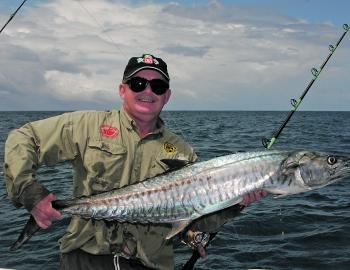
This nice barie grabbed a live frigate mackerel.
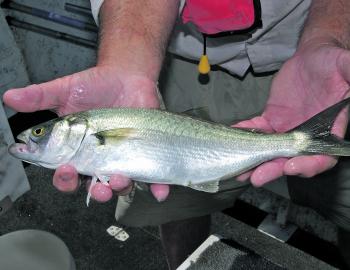
Live tailor make excellent Spanish bait.
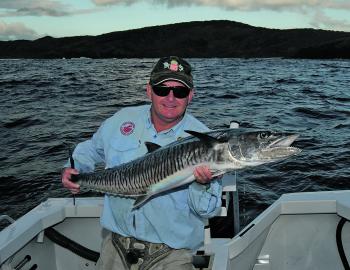
Spaniards are very active at dawn and dusk. This one came before sun-up.
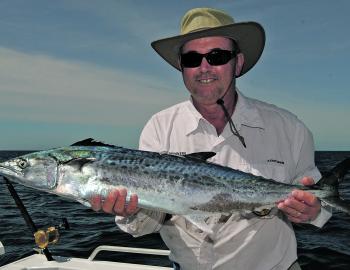
This is the average size for a spotty.
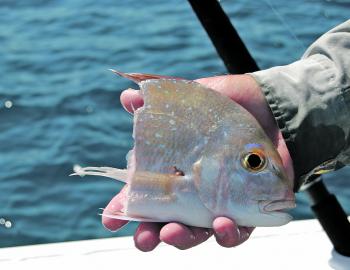
Sometimes they aren’t too fussy. This little snapper never got a chance to go back – it was smashed just behind the boat by a big mackerel.
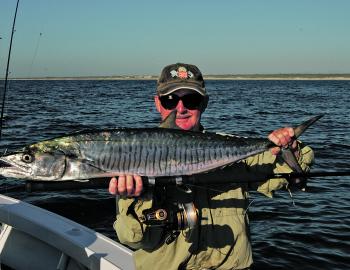
Threadline gear will easily stop mackerel of this size and bigger.

The stinger strikes again. This time it was in a live bonito.
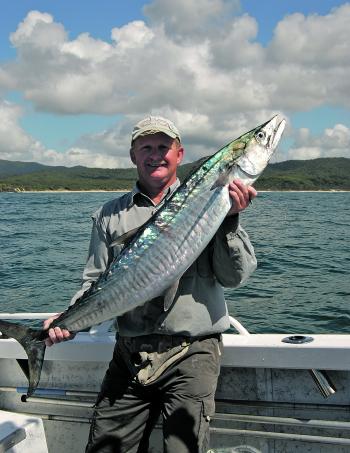
Bigger fish demand bigger gear. This fish just shaded 20kg and took a live pike.
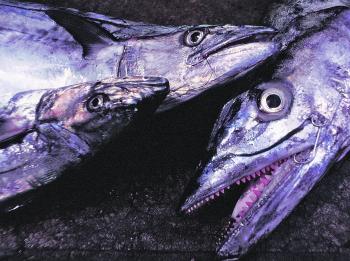
With teeth like this, large mackerel can take on quite large prey. This one was dead unlucky at 20kg+ and fell to a pilchard and no wire.
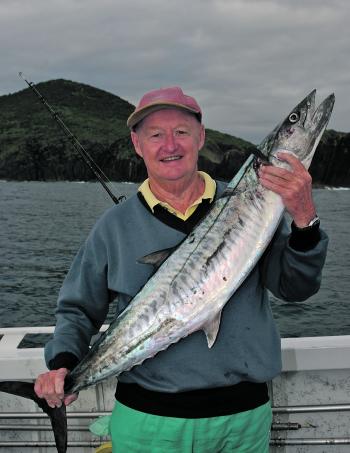
Sometimes good bait is hard to get. This one took a live yellowtail.
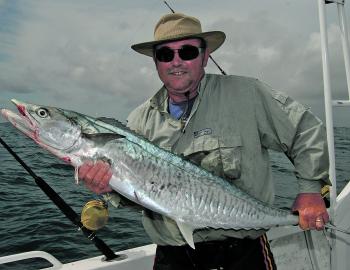
Another solid narrow barred mackerel that fell to the mackerel master Wardy on a live slimy mackerel.
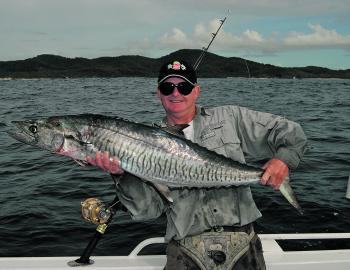
Grassy Head is a very popular spot for spotties, but sometimes the big baries move in and out comes the heavier tackle. They are always very welcome.
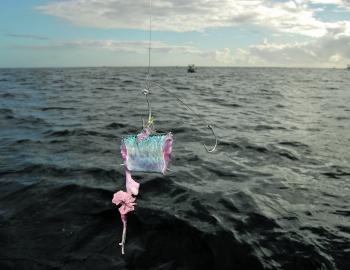
How did it miss? A fish took the head and tail, but still missed the hooks. You win some and you lose some.
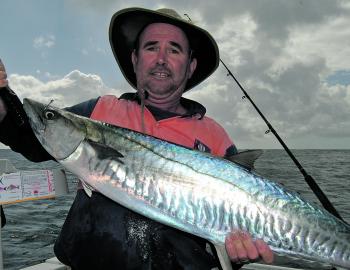
Another ripper for Wardy. Look closely the stinger hook penetrated near the eye and not the mouth.
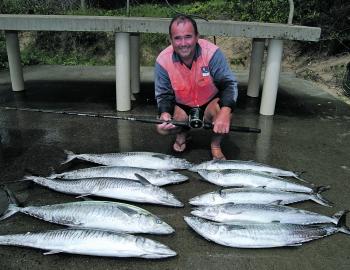
You can have a good day on the mackerel and be back home by 8am.

Sometimes you get them targeting other species. This one took a metal cast at a school of tuna and without wire too.
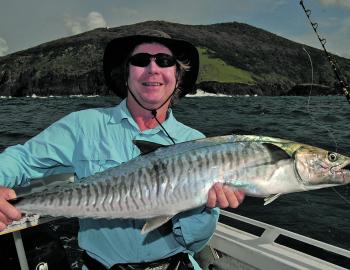
This fish was spotted on the sounder with others over sand in the middle of the day, so the downrigger was used to get the bait deep. Bingo.




